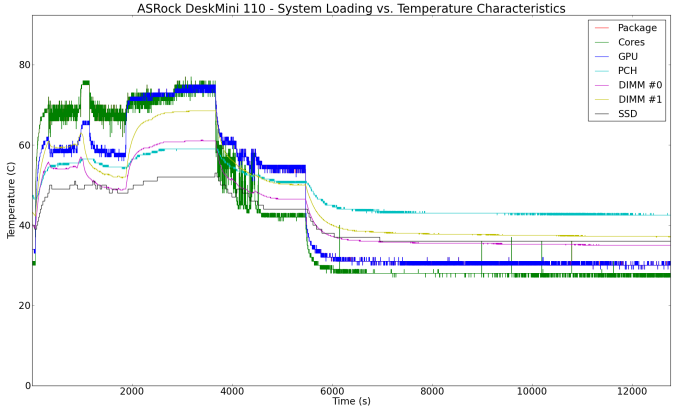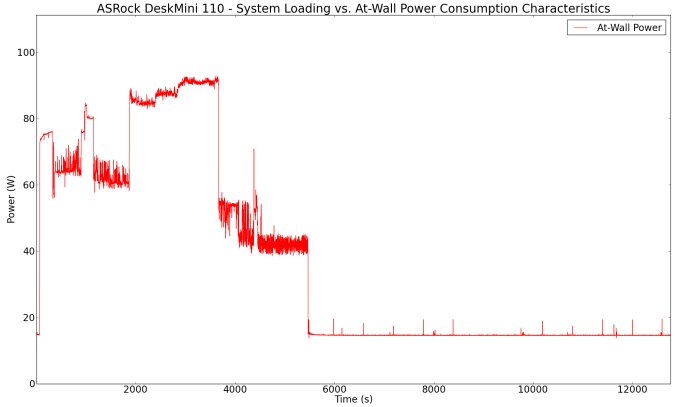ASRock DeskMini 110 mini-STX PC Review
by Ganesh T S on June 8, 2016 8:45 AM ESTPower Consumption and Thermal Performance
The power consumption at the wall was measured with a 1080p display being driven through the HDMI port. In the graphs below, we compare the idle and load power of the ASRock DeskMini 110 with other low power PCs evaluated before. For load power consumption, we ran Furmark 1.12.0 and Prime95 v27.9 together. The numbers are what one might expect for the combination of hardware components in the machine.


Our thermal stress routine starts with the system at idle, followed by 30 minutes of pure CPU loading. This is followed by another 30 minutes of both CPU and GPU being loaded simultaneously. After this, the CPU load gets removed, allowing the GPU to be loaded alone for another 30 minutes. The various clocks in the system as well as the temperatures within the unit are presented below.
According to the official specifications, the Tcase of the Core i5-6500 is 71C, and the BIOS performance curves are set to ensure that the processor doesn't go beyond that even under stress. Therefore, we see very strange package power / at-wall power consumption in the pure CPU loading case. However, things do stabilize at a higher power number when both the CPU and the GPU are loaded together.
Another important aspect to keep note of while evaluating small form-factor PCs is the chassis temperature. Using the Android version of the FLIR One thermal imager, we observed the chassis temperature after the CPU package temperature reached the steady state value in the above graph.
We have additional thermal images in the gallery below. The chassis temperatures are not a big concern even under extreme loading conditions.





















85 Comments
View All Comments
r3loaded - Wednesday, June 8, 2016 - link
Yeah, MXM was invented to make life easy for OEMs, not consumers.Flunk - Wednesday, June 8, 2016 - link
I think the ship has sailed on that idea, people want smaller and smaller notebooks, not huge ones with huge upgradability.CharonPDX - Wednesday, June 8, 2016 - link
Heck even a transverse (on a riser, across the top of the CPU,) half-height, short-length PCIe x16 slot would be nice, there are "decent", (although not "super powerful) video cards available for half-height, short-length slots.Valantar - Wednesday, June 8, 2016 - link
Thunderbolt 3 alongside similarly sized (stackable?) (MXM-based) external GPUs would be better. Want a small system with just what you need for office/HTPC duty? Skip the GPU. Want a compact gaming rig? Get the extra chassis and (given proper availability and firmware standardization) whatever MXM GPU you want. You could easily fit the "MXM+" GTX 980 (and thus 1080, whenever it's out) in a 5" by 5" form factor, and cooling would be a breeze with a heatsink filling two dimensions of the chassis fitted with a downward blowing 120mm fan.marc1000 - Thursday, June 9, 2016 - link
MXM has lots of issues.I believe if you wanna go this small, it is better to stick with NUCs. if you need some more power, go for mITX + standard GPU.
Calista - Sunday, June 12, 2016 - link
Problem is a mITX case could easily handle a 1000 watt system, going with a full-sized ATX PSU and a high-end GPU/CPU combo and a large bunch of drives. It would be noisy when going full tilt, but it would be doable. What people seem to be asking for is a <200 watt tiny system with interchangeable parts. A 200 watt TDP would allow for a small but efficient PSU to fit within a small case, a 65W CPU and a 100 watt GPU, meaning even a modern high-end GPU like the GTX 970.The mSTX form factor just sounds like the answer to a question no one has asked.
repoman27 - Friday, June 10, 2016 - link
The switch to HBM and stacking the memory and GPU on interposers will enable socketed GPUs in near future. Hopefully that becomes a thing.Namisecond - Wednesday, July 6, 2016 - link
You'd have the same problems with MXM there as you do with them on laptops, with maybe marginally more volume for a cooling system.MXM was not designed to be a user serviceable interface. The sooner you realize that, the happier you'll be. :3
SeanFL - Wednesday, June 8, 2016 - link
Glad to see more vendors gearing up in the small space PC's. Have changed over to NUC's and other small form factors in the house and at work and they work fantastic for almost everything. The monster 6 core machine (i7-5930k) only gets used for video editing now.blackice85 - Wednesday, June 8, 2016 - link
Agreed, I'm glad that these have become pretty viable now. I'm looking to replace my big PC with a smaller machine as well, but would like to still do some medium-ish quality gaming on occasion. I'm hoping the new AMD Zen APUs next year fit the bill, I'll have to see how they review. It would just be cool if a discrete GPU wasn't really a requirement anymore.